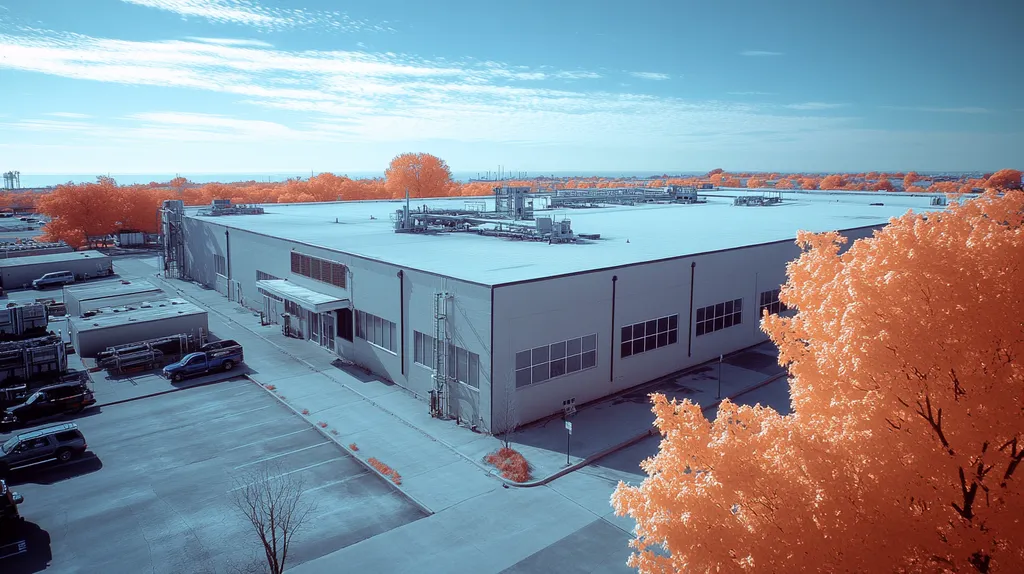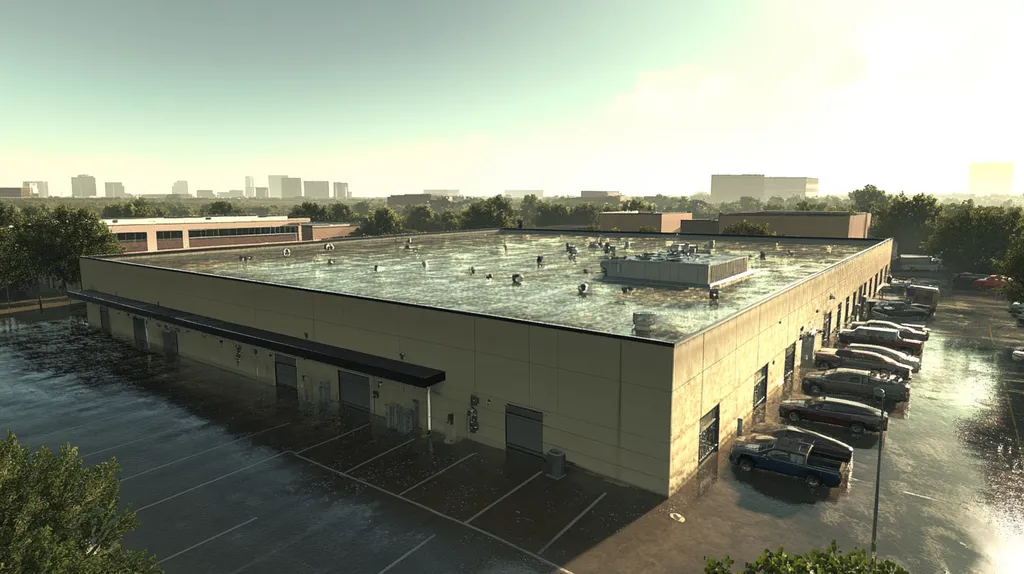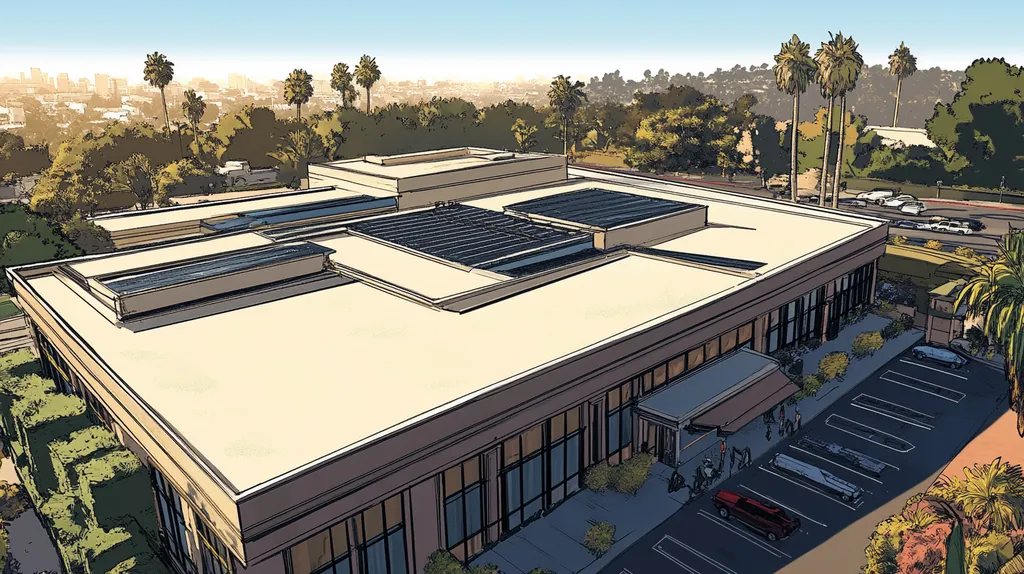Welcome to today’s Battle Royale featuring two roofing heavyweights: “Preventive Maintenance Software” in the east corner versus “Manual Inspections” in the west!
Tonight’s showdown pits these contenders against each other across six punishing rounds designed to test every aspect of their performance for Commercial Roof Maintenance.
At stake? Millions in potential costs, decades of building protection, and the critical performance demands of modern commercial and industrial facilities.
Our professional judging panel will evaluate each round on technical merit, real-world performance, and value delivery. After all six rounds, we’ll declare our ultimate champion.
Ladies and gentlemen, facility managers and building owners… it’s time to rumble!
ROUND 1: INITIAL COSTS & INSTALLATION
The stakes in commercial roofing maintenance have never been higher, with the average cost of roof replacement now exceeding $12 per square foot for basic systems. For a typical 20,000-square-foot commercial roof, making the wrong choice between preventive maintenance approaches can result in hundreds of thousands in unnecessary expenses. Let’s examine how software-based and manual inspection methods compare in terms of upfront investment and implementation.
Material Expenses
Accurate material cost tracking and forecasting directly impact a facility’s bottom line. Modern roofing systems involve multiple components, from membrane materials to fasteners and adhesives, making precise quantity calculations crucial.
Preventive maintenance software platforms provide detailed material tracking capabilities, automated inventory management, and predictive analytics for future material needs. These systems can identify cost-effective bulk purchasing opportunities and track material performance over time.
Manual inspection processes typically rely on rough estimates and historical purchasing patterns, often leading to over-ordering or emergency purchases at premium prices. This approach frequently results in material waste and storage complications.
Given its superior tracking and forecasting capabilities, preventive maintenance software claims an ADVANTAGE in material expense management.
Installation Complexity
Commercial roof installation involves coordinating multiple teams, managing safety protocols, and ensuring proper sequencing of tasks. The complexity increases exponentially with roof size and system sophistication.
Preventive maintenance software provides digital workflows, real-time progress tracking, and automated quality control checklists. These features help ensure proper installation procedures are followed and documented consistently.
Traditional manual inspection methods rely heavily on individual expertise and paper-based documentation. This approach leaves room for communication gaps and oversight of critical installation steps.
In this category, preventive maintenance software earns an ADVANTAGE through superior coordination and quality control capabilities.
Project Timeline
Installation timing impacts both direct costs and potential business disruption. Weather conditions, material availability, and crew scheduling all affect project duration.
Preventive maintenance software platforms offer automated scheduling tools, weather monitoring integration, and resource allocation features. These capabilities help optimize installation timing and reduce weather-related delays.
Manual inspection approaches often struggle with timeline management due to communication delays and reactive scheduling. Weather-related rescheduling can be particularly challenging without automated monitoring tools.
The enhanced scheduling and coordination capabilities give preventive maintenance software another clear ADVANTAGE.
ROUND 1 WINNER: Preventive Maintenance Software
ROUND 2: DURABILITY & LIFESPAN
When it comes to commercial roofing, the difference between optimal and subpar maintenance can mean hundreds of thousands in unexpected costs. A properly maintained commercial roof can last up to 50% longer compared to one that undergoes replacement every 15-20 years. This dramatic lifespan difference highlights why choosing the right maintenance approach is crucial for protecting this vital building asset. (source: Choice Roof Contractors)
Impact on Lifespan
Commercial roof lifespans vary dramatically based on the effectiveness of maintenance programs. Regular, systematic inspections and repairs can extend a roof’s functional life by decades, while sporadic maintenance often leads to premature failure.
Preventive maintenance software establishes consistent inspection schedules, tracks repair history, and alerts facility managers to potential issues before they become critical. These systems ensure no maintenance tasks slip through the cracks, while providing detailed documentation for warranty claims.
Manual inspection processes rely heavily on individual inspector memory and paper records, which can result in missed maintenance intervals and incomplete documentation. This inconsistency often leads to warranty disputes and shortened roof lifespans.
For maximizing roof lifespan through systematic care, preventive maintenance software claims an ADVANTAGE.
Durability Under Stress
Environmental stressors like UV exposure, temperature fluctuations, and precipitation pose constant threats to roof integrity. Early detection and response to these threats directly impacts how well a roof withstands these challenges.
Preventive maintenance software platforms utilize weather data integration and automated scheduling to ensure inspections occur after significant weather events. These systems can also track patterns of wear in specific roof areas, enabling targeted preventive measures.
Traditional manual inspections typically follow fixed schedules that may not align with actual environmental conditions. This rigid approach can miss critical damage assessment opportunities after severe weather events.
The responsive nature of software-based monitoring earns it an ADVANTAGE in maintaining durability under stress.
Cost Implications of Durability
The financial impact of roof durability extends far beyond initial maintenance costs. Extended roof life means fewer replacements, reduced repair expenses, and better protection of building assets.
Preventive maintenance software provides detailed cost tracking, enabling accurate budget forecasting and ROI analysis. These platforms help identify cost-effective repair timing and can demonstrate the financial benefits of proactive maintenance.
Manual inspection methods often struggle to provide comprehensive cost analysis, making it difficult to justify maintenance expenditures or plan for future expenses. This can lead to delayed maintenance and higher long-term costs.
The superior financial tracking and planning capabilities give preventive maintenance software an ADVANTAGE.
ROUND 2 WINNER: Preventive Maintenance Software
ROUND 3: PERFORMANCE FACTORS
Commercial roofing performance directly impacts building protection and operational costs. Recent industry data shows that facilities with inadequate roof monitoring face up to 85% higher maintenance costs than those using systematic inspection approaches. For property owners and facility managers, the choice between preventive maintenance software and manual inspections can mean the difference between proactive protection and costly reactive repairs.
Data Accuracy and Reporting
Accurate data collection and analysis form the foundation of effective roof maintenance decisions. Without precise tracking of roof conditions, even minor issues can develop into major problems before detection.
Preventive maintenance software utilizes digital sensors, automated measurements, and standardized inspection protocols to capture detailed roof condition data. These systems generate comprehensive reports with trending analysis and photographic documentation, ensuring consistent evaluation criteria across inspections.
Manual inspections rely heavily on individual inspector judgment and paper-based documentation. This approach introduces variability in assessment criteria and makes historical comparisons difficult, often leading to inconsistent evaluations across different inspectors or time periods.
The superior consistency and documentation capabilities give preventive maintenance software a clear ADVANTAGE in data accuracy.
Efficiency of Maintenance Operations
Operational efficiency in roof maintenance directly affects both costs and building protection. Quick identification and response to emerging issues can prevent minor problems from escalating into major repairs.
Preventive maintenance software platforms provide real-time monitoring, automated scheduling, and instant alert capabilities. These features enable rapid response to developing issues and ensure maintenance tasks are properly sequenced and tracked.
Traditional manual inspection processes typically operate on fixed schedules with delayed reporting and response times. Communication delays between inspectors, maintenance teams, and property managers can result in extended repair timelines.
The enhanced coordination and response capabilities give preventive maintenance software an ADVANTAGE in operational efficiency.
Cost-Effectiveness Over Time
Long-term cost control requires both effective issue detection and strategic maintenance planning. The timing of interventions significantly impacts repair costs and roof longevity.
Preventive maintenance software tracks degradation patterns and predicts potential failure points before they occur. This predictive capability enables planned interventions during optimal weather conditions and helps prevent emergency repairs.
Manual inspection approaches often miss early warning signs of deterioration, leading to reactive repairs under challenging conditions. Emergency repairs typically cost 3-5 times more than planned maintenance activities.
The predictive capabilities and strategic planning features give preventive maintenance software an ADVANTAGE in cost-effectiveness.
ROUND 3 WINNER: PREVENTIVE MAINTENANCE SOFTWARE
ROUND 4: MAINTENANCE REQUIREMENTS
The stakes in commercial roof maintenance have never been higher, with proper maintenance programs saving building owners up to 50% over a 30-year roof lifespan compared to periodic replacements. Annual maintenance programs typically cost just 1-3% of total roof replacement costs while dramatically extending roof life and preventing catastrophic failures. These stark financial differences highlight why choosing the right maintenance approach is crucial for protecting valuable roofing assets. (source: Choice Roof Contractors)
Regularity and Reliability of Inspections
Systematic inspection schedules form the foundation of effective roof maintenance. Regular evaluations help identify potential issues before they develop into costly problems requiring emergency repairs.
Preventive maintenance software platforms ensure consistent inspection timing through automated scheduling and reminder systems. These systems track inspection history, upcoming maintenance needs, and warranty requirements to prevent oversight.
Manual inspection processes often suffer from scheduling inconsistencies and missed maintenance intervals. Human factors like staff turnover, competing priorities, and paper-based tracking can disrupt regular inspection patterns.
The automated scheduling and tracking capabilities give preventive maintenance software a clear ADVANTAGE in inspection reliability.
Documentation and Compliance
Proper documentation of maintenance activities protects warranty coverage and enables strategic planning. Missing or incomplete records can void manufacturer warranties and complicate insurance claims.
Preventive maintenance software creates detailed digital records of all inspections, repairs, and material conditions. These systems generate comprehensive reports with photos, measurements, and historical trending data.
Traditional manual methods rely on paper forms and individual record-keeping practices. This approach often results in inconsistent documentation and difficulty accessing historical maintenance records.
The superior record-keeping capabilities give preventive maintenance software an ADVANTAGE in documentation.
Resource Management
Effective maintenance requires coordinating personnel, materials, and equipment. Poor resource management leads to maintenance delays and increased costs.
Preventive maintenance software optimizes resource allocation through automated scheduling and inventory tracking. These systems help prevent material shortages and ensure proper staffing for maintenance tasks.
Manual inspection approaches struggle with resource coordination due to communication gaps and reactive planning. This often results in rush orders for materials and inefficient use of maintenance personnel.
The enhanced coordination capabilities give preventive maintenance software an ADVANTAGE in resource management.
ROUND 4 WINNER: Preventive Maintenance Software
ROUND 5: SUSTAINABILITY CREDENTIALS
The environmental impact of commercial roofing has become increasingly critical, with sustainable practices now directly affecting both operational costs and corporate responsibility goals. Studies show that optimized roof maintenance can reduce building energy consumption by up to 30% while minimizing material waste. Regular roof inspections can pinpoint potential issues before they escalate, significantly impacting both environmental footprint and costs. (source: Economy Restoration)
Environmental Impact
Commercial roofs play a crucial role in building energy efficiency and environmental footprint. The way these systems are maintained directly affects their ability to provide proper insulation and reflect solar heat.
Preventive maintenance software platforms utilize sensors and data analytics to monitor thermal performance and identify energy efficiency losses in real-time. These systems can detect minor insulation failures or moisture infiltration before they impact building energy consumption.
Manual inspection methods typically rely on visual assessments that may miss subtle efficiency losses. This limitation often leads to prolonged periods of suboptimal performance and increased energy usage.
For maintaining optimal environmental performance, preventive maintenance software claims an ADVANTAGE.
Material Conservation
Sustainable roofing practices require maximizing material lifespan while minimizing waste. Early detection of deterioration helps prevent unnecessary material replacement and reduces landfill impact.
Preventive maintenance software tracks material degradation patterns and enables targeted interventions before complete replacement becomes necessary. These systems help optimize the timing of protective coating applications and repairs.
Traditional manual inspections often miss early signs of material degradation, leading to premature replacement requirements. This reactive approach typically results in more materials being sent to landfills.
The superior material optimization capabilities give preventive maintenance software an ADVANTAGE.
Regulatory Compliance
Environmental regulations for commercial buildings continue to become more stringent. Maintaining detailed records of sustainability measures and energy performance is increasingly essential for compliance.
Preventive maintenance software automatically generates comprehensive documentation of energy efficiency measures and material conservation efforts. These platforms ensure compliance requirements are met and properly documented.
Manual inspection processes struggle to maintain the detailed records required by modern environmental regulations. Paper-based systems often lack the precision needed for energy performance tracking.
The automated compliance tracking gives preventive maintenance software an ADVANTAGE.
ROUND 5 WINNER: PREVENTIVE MAINTENANCE SOFTWARE
ROUND 6: SPECIALIZED APPLICATIONS
Commercial roofing maintenance has become increasingly complex, with specialized applications demanding precision and systematic oversight. Modern roofing systems now incorporate photovoltaic installations, green roof sections, and sophisticated drainage networks that require careful coordination of maintenance activities. Property owners face critical decisions about how to monitor and maintain these specialized systems effectively.
Specialized System Integration
Modern commercial roofs often incorporate multiple specialized systems that require careful maintenance coordination. These may include solar installations, HVAC equipment, and various penetrations that create complex maintenance requirements.
When installing specialized systems like photovoltaic panels, proper spacing and access planning are essential for long-term maintenance efficiency. Row spacing between panels must accommodate maintenance crews while maximizing energy production potential. (source: Insurance Institute for Business & Home Safety)
Preventive maintenance software platforms provide detailed mapping of specialized systems and their maintenance requirements. These systems track inspection schedules specific to each component while ensuring proper access protocols are maintained.
Manual inspection methods often struggle to coordinate maintenance across multiple specialized systems. This can result in overlooked components and insufficient documentation of system-specific requirements.
For managing complex system integration, preventive maintenance software claims an ADVANTAGE.
Equipment Access Planning
Safe and efficient access to rooftop equipment requires careful planning and documentation. Poor access management can lead to damaged membranes and compromised system integrity.
Preventive maintenance software creates detailed access route maps and maintenance corridors that protect both equipment and roofing materials. These systems can optimize maintenance scheduling to minimize foot traffic and equipment movement across vulnerable areas.
Traditional manual approaches typically rely on memory and experience for access planning. This can result in inconsistent routes and unnecessary wear patterns on the roof surface.
The systematic approach to access management gives preventive maintenance software an ADVANTAGE.
Specialized Monitoring Requirements
Different roofing components require varying inspection frequencies and monitoring protocols. Managing these diverse requirements becomes increasingly complex as system sophistication grows.
Preventive maintenance software platforms automatically adjust inspection schedules based on manufacturer specifications and component performance data. These systems ensure each specialized element receives appropriate attention at optimal intervals.
Manual inspection processes often apply one-size-fits-all approaches to diverse system components. This can result in over-inspection of some elements while missing critical checks on others.
The ability to customize monitoring protocols gives preventive maintenance software an ADVANTAGE.
ROUND 6 WINNER: Preventive Maintenance Software
AND THE WINNER IS…
After six grueling rounds of technical evaluation, we have our verdict…
In a commanding performance that left no doubt about superiority, PREVENTIVE MAINTENANCE SOFTWARE claims a decisive victory with a clean sweep across all six rounds!
The champion dominated through superior data accuracy, automated scheduling, and comprehensive documentation capabilities. Its integration of real-time monitoring, predictive analytics, and systematic inspection protocols proved unstoppable in maximizing roof lifespans while minimizing costs.
However, traditional manual inspections still hold their corner in specific situations – particularly for smaller facilities with simple roof systems and experienced in-house maintenance teams who know their buildings intimately.
Important Notice: Every commercial property faces unique challenges based on local climate, building design, and operational requirements. While this analysis provides general guidance, it cannot account for all variables that might affect your specific situation. Always consult qualified roofing professionals who can evaluate your building’s particular needs and circumstances.
Ladies and gentlemen, the bell has rung on this heavyweight matchup. But remember – in the high-stakes arena of commercial roofing, true victory comes not from blindly following the champion, but from strategically selecting the maintenance approach that best protects your specific roofing investment.
FREQUENTLY ASKED QUESTIONS
Q. What are the initial costs of commercial roof maintenance software?
A. Initial costs include software licensing, installation, and training expenses. These costs can vary based on the complexity of the software chosen. However, investing in preventive maintenance software can lead to significant savings by reducing unnecessary expenses over time.
Q. How does a commercial roof’s durability change with software?
A. Durability improves as software schedules regular inspections and identifies potential issues early. Enhanced monitoring and timely repairs help maintain the roof’s integrity, significantly extending its lifespan compared to sporadic manual inspections.
Q. How does performance differ between commercial roof inspection methods?
A. Software offers precise data tracking, improving maintenance decisions and minimizing costs. In contrast, manual inspections can be inconsistent, leading to missed issues and potentially escalating repair costs over time.
Q. What are the maintenance requirements for commercial roofs?
A. Regular inspections, prompt repairs, and thorough documentation are essential. Software helps automate these processes, ensuring no tasks are overlooked and compliance requirements are met, while manual methods risk missing critical maintenance opportunities.
Q. How can preventive maintenance software support sustainability in commercial roofing?
A. Software enables efficient monitoring of energy performance and helps optimize repairs. This proactive approach reduces energy consumption and material waste, contributing to environmental sustainability while enhancing overall roofing performance.
Q. What are specialized applications of commercial roofing?
A. Specialized applications include systems like green roofs, solar installations, and advanced drainage. Software helps effectively manage the unique maintenance requirements of these systems, ensuring optimal performance and longevity.
Q. How do I choose the right maintenance approach for my industrial roof?
A. Assess your roof’s specific needs, considering factors like lifespan, complexity, and budget. Choosing a preventive maintenance strategy supported by software can drastically enhance longevity and performance, compared to traditional methods.










